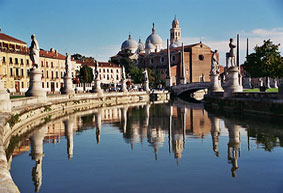


All the structures

Padua in the province of Veneto is one of Italy’s oldest cities. Padua is very important for its art, history and culture, which is evident from the wonderful buildings that attract the visitor’s attention: the Romanesque Baptistery and its many frescoes, Piazza dei Signori, Piazza delle Erbe, famous for its fruit and vegetable market, the Town Hall and the Palazzo della Ragione with works by Giotto.
Padova has the world’s oldest Botanical Gardens (World Heritage site) dating back to 1545. Early in its history it was used for cultivating medicinal plants, then under Dr. Francesco Bonafede it became the source of botanical studies, now run by the University of Padua, where in 1592 Galileo Galilei held the Chair of Mathematics. Inside the Botanical Gardens you can see its oldest tree, a S. Peter’s palm dating back to 1585 that Goethe made famous by mentioning it in some of his writings.
Only some of the great monuments that make Padua world-famous are mentioned here. Among them is the Basilica of S. Anthony, built between 1232 and 1300 to house the tomb of S. Anthony of Padua. The Basilica of S. Anthony is one of the most famous Shrines and visited by pilgrims from all over the world.
Visit the dell'Arcella Sanctuary two kilometres from Padua, which contains the cell from the old convent.
Music lovers should visit the Music Salon or the Hall of the ‘upside-down guitar’ at Villa Contarini Camerini. Selvazzano Dentro, another town in the lovely province of Padua, is famous for its Parish Church and its unspoilt environment.